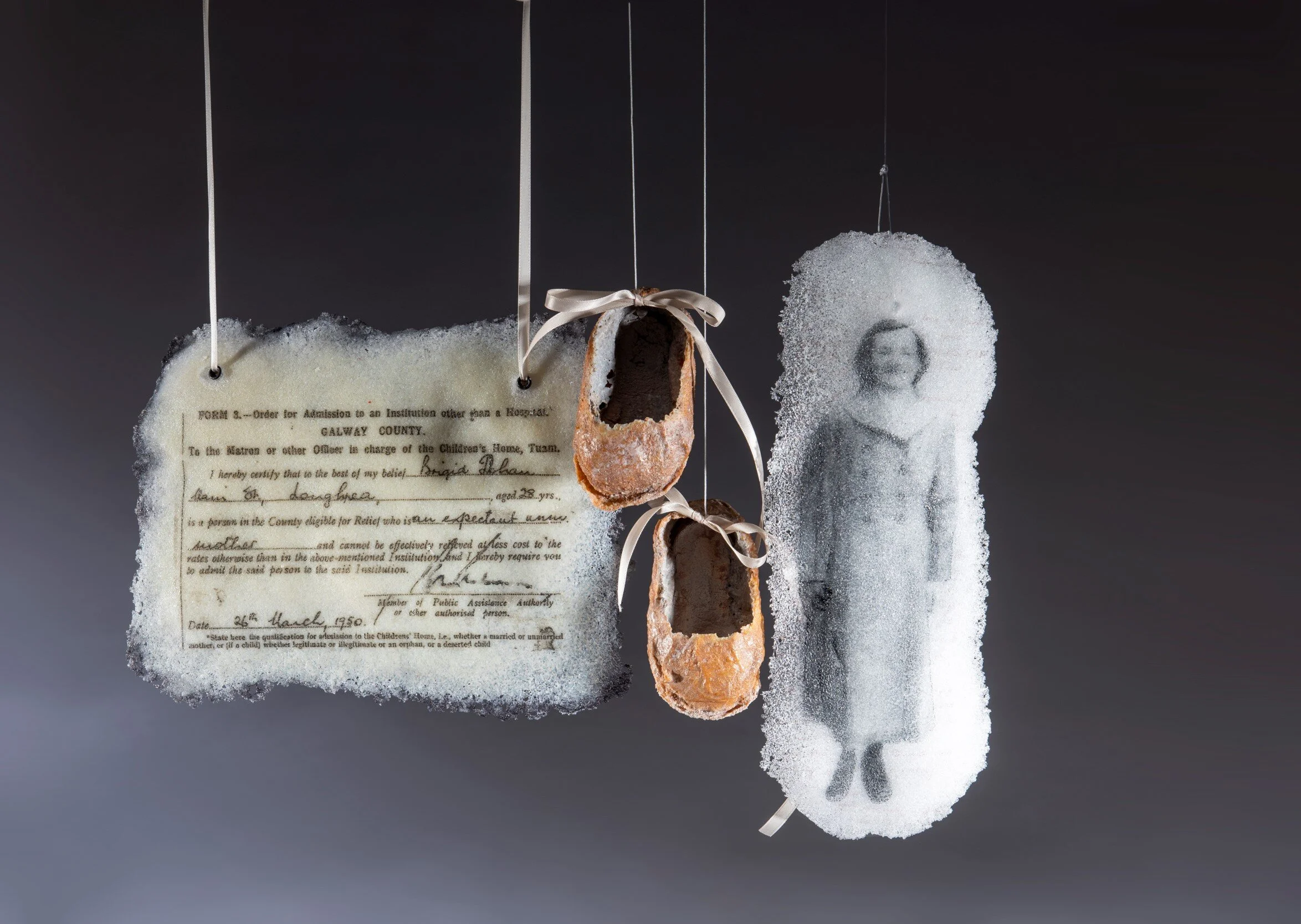The exhibition (A)Dressing our Hidden Truths opened at The National Museum of Ireland in March 2019. It is the brainchild of curator Dr Audrey Whitty and artist Alison Lowry. The exhibition is an artistic response to the legacy of Magdalene Laundries and Mother and Baby Homes in Ireland.
The Magdalene Laundries operated in Ireland throughout the 18th and 19th centuries. It is estimated that 30,000 Irish women went through the laundry system in that time. To begin with the idea was to rescue and rehabilitate ‘fallen’ woman, but quickly the laundries became commercially driven and women and girls were committed to the laundries as ‘inmates’ for no real reason and used as free labour by the religious orders who ran them. The regime was harsh and unrelenting. On entering a laundry your name would have been changed, possessions removed and a uniform given. Women were expected to work long hours in awful conditions with very little food. Talking was forbidden and punishments were frequent.
The Irish State enabled the Magdalene laundries to continue running all those years. But in February 2013, Enda Kenny acknowledged this wrong and apologised publicly in the Dáil to all those affected. Here is an excerpt from his speech:
The Magdalene Women might have been told that they were washing away a wrong or a sin but we now know, to our shame, they were only ever scrubbing away our nation’s shadow. Today, just as the State accepts its direct involvement in the Magdalene Laundries, society too has its responsibility. I believe I speak for millions of Irish people all over the world when I say we put these women away for too many years because we put away our conscience. We swapped our personal scruples for a solid public apparatus that kept us in tune and in step with a sense of what was ‘proper behaviour’ or the ‘appropriate view’ according to a sort of moral code that was fostered at the time, particularly in the 1930s, 40s and 50s. We lived with the damaging idea that what was desirable and acceptable in the eyes of the Church and the State was the same thing and interchangeable. Therefore, I, as Taoiseach, on behalf of the State, the government and all our citizens deeply regret and apologise unreservedly to all those women for the hurt that was done to them and for any stigma they suffered, as a result of the time they spent in a Magdalene Laundry.
These are their names, Numbers 13:4.
The real names of the women, taken from the 1911 census, that were incarcerated in the Waterford laundry at the time
Reproduced with kind permission of ‘The Magdalene Names Project’ from JFM Research.
Punishments in the Laundry were frequent and cruel. Women and girls would have been held down whilst their hair was hacked off by the nuns or orderlies.
Since Irish Independence 10,000 women were forced into servitude in the Laundries. The last Laundry closed in 1996.
Here, 10,000 paper dolls spill out of church offertory plates. The paper dolls have been cut from (replica) £5 notes, that happen to bear the image of Catherine McAuley – the founder of the Religious Sisters of Mary.
A Nations Shame
Sheets embroidered with an inscription from the ‘Magdalene Seat’ at St Stephens Green in Dublin.
Connie Roberts, the author of ‘The Cardigan’, grew up in an Industrial School in Ireland. The industrial school system was heavily criticised in the Ryan Report in 2009.
Here we see Brigid Dolan’s admission form into the Bon Secours Mother and Baby Home, Tuam, Co Galway. These homes housed unwed mothers until they had delivered their babies. The babies were frequently adopted, often without any consent being given by their mothers.
Home Babies, 2017
There also includes an installation of 9 glass Christening Robes with audio, commemorating the 796 children ‘buried’ in a disused septic tank on the Tuam Mother and Baby Home site.
A New Skin, 2017
A sculptural piece that explores ‘rape culture’ in today’s society. Leatherwork by Úna Burke.
This collaborative video piece with artist Jayne Cherry is a performance work in which Cherry attempts to take 35 steps in heavy glass slippers to illustrate how hard it is for women to leave abusive relationships. It attempts to illustrate the statistic that on average a woman will be assaulted 35 times by her partner before she will call the police.
(A)Dressing Our Hidden Truths runs at the National Museum of Ireland until May 2020. For further information see here.
Thank you to the National Museum of Ireland, Alison Lowry and Brian Houlihan for facilitating the creation of this photo essay for Herstory.













